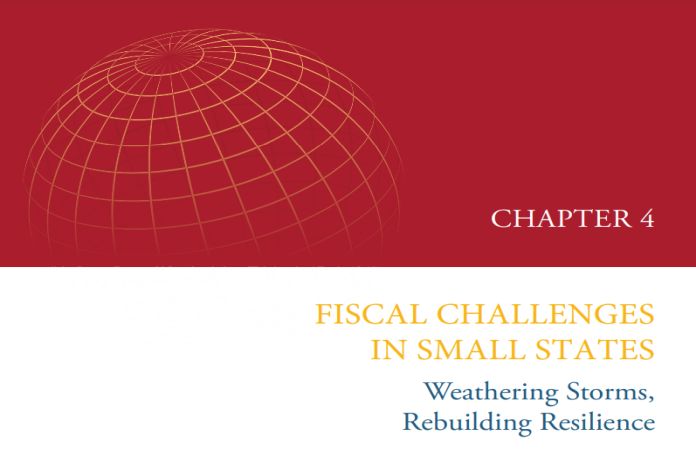By Sam Hill and Jeetendra Khadan
Small states, those with a population of 1.5 million or less, face significant fiscal challenges arising from common vulnerabilities. Many of them are tropical islands, and highly exposed to costly natural disasters, particularly storms and other weather-related events that have become more frequent with climate change. Additionally, their high economic openness and narrow export bases expose them to adverse external developments, notably global recessions. This greater exposure to external shocks translates into greater output and fiscal volatility than in other emerging market and developing economies (EMDEs), both in terms of more volatile spending and revenues, and sharper deteriorations in fiscal positions.
New empirical analysis highlights the fiscal damage inflicted on small states by the two types of external shocks that they are often most vulnerable to large natural disasters and global recessions. An event analysis shows that both types of event significantly weaken fiscal balances and increase government debt, relative to GDP, in small states. For example, three years after a large natural disaster or global recession, fiscal balances in small states deteriorate by, on average, around 1.8 percentage points . Three years after a global recession, debt ratios increase by 3.5 percentage points and three years after a natural disaster, by 6 percentage points. Moreover, both types of event are found to have larger adverse impacts on small states than other EMDEs.
A significant decline in fiscal sustainability among small states in recent years has made strengthening fiscal policy perhaps the most pressing economic challenge facing them. This is particularly critical given the crucial role fiscal policy plays in macroeconomic stabilization in small states and the absence in most cases of exchange rate flexibility. Reforms targeting both expenditure and revenue streams can reverse deteriorating fiscal positions while building resilience for the future. Given the outsized shocks facing small states, these need to be coupled with fiscal frameworks that are even more resilient than those of other EMDEs.
Although small states’ government revenues-to-GDP ratios are on average higher than other EMDEs, they rely more on less reliable non-tax sources. These include grants from international donors, which are subject to the evolving priorities of donors, and other revenue sources such as proceeds from the sale of fishing access rights and citizenship investment programs. There are also inefficiencies and gaps within the current tax structure for small states. Notably, almost one-quarter of tax revenues in small states are derived from distortive trade taxes, more than double the share in other EMDEs. Small states should therefore prioritize expanding tax bases, particularly by introducing value-added taxes where they do not exist, removing tax exemptions that create distortions and complicate tax collection, and strengthening tax administration to enhance compliance and revenue collection, including through the use of digital technologies.
At the same time, small states need to make better use of already high levels of government spending. Although higher spending in small states compared with other EMDEs can partly be explained by diseconomies of scale, there are areas of inefficiencies, partly reflected in the composition of government spending that could be improved. In particular, the public wage bill is markedly higher in small states than other EMDEs. There are also challenges associated with wasteful energy subsidies, and outsized and inefficient state-owned enterprises that require large transfers from government coffers. There is ample room for small states to improve expenditure efficiency, including through repurposing of poorly targeted transfers and inefficient subsidies, strengthening public financial management, and utilizing digital innovations to lower public service delivery costs and enhance service quality.
Gaps in fiscal frameworks in small states relating to the adoption of key policy instruments, namely fiscal rules, fiscal councils, and sovereign wealth funds also need to be addressed. Only about one-third of small states have adopted some type of fiscal rule, compared with half of other EMDEs. Only a few small states have adopted independent fiscal councils, representing an even lower share than other EMDEs. Finally, although some small states have sovereign wealth funds, and other stabilization funds, these could be better used. These funds vary in size, design and goals and aren’t always ideally configured to help smooth volatility. Some function as trust funds supported by donors to secure long-term budget self-reliance while others have a strong focus on investment and development objectives. In contrast, far fewer emphasize clear stabilization roles.
The global community must continue to support small states in addressing their fiscal challenges. Concessional loans, grants, and private capital mobilization are crucial, as domestic revenues falter and climate adaptation costs soar. At the same time, addressing unsustainable debt is urgent, with a third of small states having restructured debt since 2003. International collaboration on debt transparency and technical assistance is vital for these nations to implement fiscal reforms and enhance policymaking for sustainable development.
In tandem, innovative financing, like debt-for-climate swaps, has seen some small states exchange debt relief for conservation efforts. Insurance mechanisms and risk pooling can also offer fiscal buffers against natural disasters. This includes various regional initiatives such as the Caribbean Catastrophe Risk Insurance Facility, which recently provided a payout following damage caused by hurricane Beryl.
The unique structural characteristics of small states constrain their fiscal policy. However, these obstacles are not insurmountable. Governments in small states retain the capacity to build fiscal resilience, with support from the international community.






